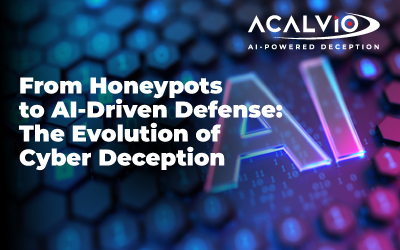
Cybersecurity has witnessed a dramatic evolution over the decades, particularly in the realm of deception technologies. What began as static honeypots has now transformed into sophisticated, AI-driven active and preemptive defense systems. Here’s a look at this journey, tracing key innovations that have reshaped how organizations outsmart attackers.
Honeypots: The Pioneers of Cyber Deception
Honeypots, first introduced in the early 1990s, were the trailblazers of deception technology. These standalone systems mimicked real assets, luring attackers into engaging with them. The value of honeypots lay in their ability to isolate malicious activity and provide insight into attacker tactics. However, they were inherently static, resource-intensive, and vulnerable to discovery by skilled adversaries, which limited their effectiveness as attackers became more sophisticated.
Honey Nets and Honeypot Networks
To address the shortcomings of individual honeypots, honey nets were introduced. These networks of interconnected decoys simulated more realistic environments, enabling defenders to observe lateral movement and multi-stage attacks. By creating a larger and more complex attack surface, honey nets provided deeper insights into adversarial behavior. Despite their advantages, they demanded significant maintenance and operational resources, which limited their scalability.
Canaries and Honeytokens: Lightweight and Scalable Deception
The next step in deception technology was the introduction of canary tokens and honeytokens. These lightweight tools shifted the focus from high-maintenance systems to scalable, cost-effective traps. A canary might be a fake email account or document that triggers an alert upon interaction, while honeytokens included deceptive credentials, API keys, or database records. This approach allowed defenders to expand deception across their environments with minimal operational overhead, making it accessible to organizations of all sizes.
Dynamic Deception: Advanced Platforms for Modern Threats
With the rise of dynamic deception platforms, the game changed again. These platforms automated the creation and deployment of deception assets—ranging from fake user accounts and file shares to IoT devices and entire virtual networks. More importantly, they integrated seamlessly with existing infrastructure and offered forensic capabilities, enabling defenders to investigate attacker behavior with greater precision. The ability to dynamically adapt deception assets to evolving threats marked a significant leap forward.
AI-Powered Deception and Active Defense
We are now in the era of AI-driven deception and active defense, where deception technologies are not only dynamic but also intelligent. AI enables scalable deployment of decoys that continuously adapt to mimic production environments, making it exponentially harder for attackers to differentiate real assets from fake ones. Behavioral analytics, real-time threat intelligence, and decision-making powered by AI amplify detection capabilities. These systems don’t just detect and respond—they engage attackers, delay their progress, and provide defenders with actionable insights. Moreover, they integrate with SOAR, EDR, and other security tools to automate responses and reduce mean time to detect and respond.
Preemptive Defense: Shaping the Attacker’s Journey
Today’s most advanced deception technologies aim to preempt attacks entirely. AI models proactively identify vulnerabilities and deploy tailored deceptive assets, shaping the attacker’s decision-making process before they even launch an attack. Identity-based deceptions, such as fake credentials or decoy Active Directory objects, weaponize deception as a strategic tool in active defense. These innovations align deception with broader security strategies like zero trust and identity threat detection, making it a cornerstone of proactive cyber defense.
The Future of Deception: Autonomous Defense Systems
The future lies in the fusion of deception, AI, and autonomous systems. This convergence enables defenders to scale deception efforts, automate decision-making, and manipulate adversaries at scale. Machine learning, real-time threat modeling, and advanced behavioral analysis will further enhance the ability to detect and neutralize threats before they cause harm. The goal is not just to react to attacks but to exhaust adversaries and render their efforts ineffective.
Conclusion
Deception technology has evolved from static honeypots to intelligent, AI-driven systems that actively defend against threats. Each stage of this evolution—from honeypots to honeytokens, dynamic platforms, and AI-powered deception—has brought defenders closer to achieving asymmetric advantages over attackers. In today’s threat landscape, where adversaries are increasingly sophisticated, deception is no longer a tool of observation but a weapon of disruption.
Organizations that leverage AI-powered deception are not just keeping pace with attackers; they are redefining the rules of engagement, turning the cyber battlefield into one where defenders have the upper hand. As technology continues to evolve, the question isn’t whether to adopt deception—it’s how to make it a cornerstone of your security strategy.




